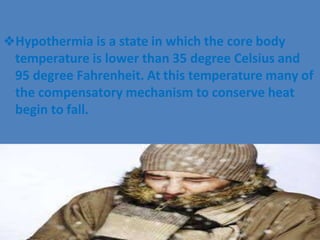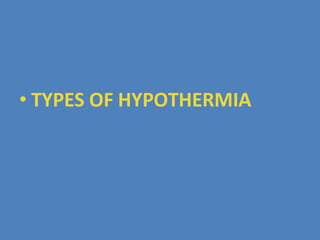Temperature.ppt.
- 1. TEMPERATURE Mrs. Sapana thakor Lecture NSIN ,, AHMEDABAD
- 2. ❑Body temperature is the degree of hotness or coldness of a body or environment. ❑It is the somatic sensation of heat or cold. It is the degree of or intensity of heat of a body in relation to external environment. ❑The body temperature is the difference between the amount of heat produced by body processes & the amount of heat lost to the external environment.
- 3. • Body Temperature = Thermogenesis–Heat Loss
- 4. Normal temperature Vary between 97-99 f and 36.1-37.2 c Axillary- 97.6 f Oral – 98.6 f Rectal- 99.6 f
- 5. urinary bladder • Core temperature- it is the temperature of internal body tissues below the skin & subcutaneous tissues. The sites of measurement are rectum, tympanic membrane, esophagus, pulmonary artery & .
- 6. • Surface body temperature- it refers to the body temperature of external body tissues at the surface that is of the skin & subcutaneous tissues. SITES
- 7. It is precisely regulated by physiological & behavioral mechanisms in number of ways:- ❑Neural control ❑Vascular control ❑Skin in temperature regulation ❑Behavioral control
- 10. ✓Fever is an elevation of body temperature that exceeds normally daily variation and occurs in conjunction with an increase in the hypothalamic set point for e.g. 37⁰C-39⁰C.
- 11. CAUSES OF FEVER -infection -neoplasms -vascular causes -trauma -immunological diseases. -endocrine
- 12. 1. Intermittent fever: Temperature rise frome normal to high and come down at regular interval.E.g.- in septicemia. 2.Remittent fever the variation is more than 2 c between morning and evening but fever does not reach normal.
- 13. s 4.Relapsing fever: there are short febrile periods followed by one or more day of normal temperature.
- 14. 5.Constant or continuous The temperature varies not more than 2 c b/w morning and evening, but does not come to normal during the day.
- 15. 1) low pyrexia: 99-101 f 2) moderate pyrexia-101-103 f 3) high pyrexia: 103-105 f 4) hyperpyrexia: 105 f
- 16. Management of sever fever • Five oral fluids 3 liter per day. • Give cold sponge to reduce bod’s surface temperature. • Give frequent mouth wash and attend to oral hygiene. • Reduce the external covering on petient body to promote heat loss through radiation and conduction.
- 17. • Do not induce chills • Keep clothing and bed linen drey to increase heat loss through conduction and convection • Provide cool circulating air • Limit patients physical activity and provide rest. • Check out temperature 1/2 hourly and record to assess the genearl condition of patient,
- 18. GOAL •Patients suffering from balance thermoregulation •Temperature in Normal range •Pulse and respiration in normal range •No color change •No turning.
- 19. Nursing management Fever control 1. Monitor temperature at lease every 2 hourly 2. Monitor in continuous basal temperature 3. Monitor bp , pulse and respiration. 4. Moniyor skin color and temperature. 5. Monitor level of consciousness. 6. Monitor count of WBC ,Hb , Hct.
- 20. 7.monitor intake and output. 8.give antipyretic. 9.provide treatment to overcome the cause of fever. 10.provide intravenous fluids. 11. Compress the patient on the thigh fold , axilla and neck. 12. Increase air circulation 13. Provide treatment to prevent shivering.
- 21. Nursing process
- 22. RIGOR Rigor is a sudden attack of intense shivering when the heat regulating center in the brain is disturbed. It is seen in certain infection like malaria .
- 23. Stages of rigor 1. Cold stage 2. Hot stage 3.sweting stage
- 24. ❖Hypothermia is a state in which the core body temperature is lower than 35 degree Celsius and 95 degree Fahrenheit. At this temperature many of the compensatory mechanism to conserve heat begin to fall.
- 25. • TYPES OF HYPOTHERMIA
- 26. • Normal Range: – 98.6º F • Mild Hypothermia: – 89.95º F • Moderate hypothermia- 82-89 f • SevereHypothermia – < 82º F
- 27. ❖Cold exposure-when the balance between the body’s heat production and heat loss tips toward heat loss for a prolonged period, hypothermia can occur. ❖Accidental hypothermia usually happens after cold temperature exposure without enough warm, dry clothing for protection.
- 28. symptoms • Shivering • Slow, shallow breathing • Confusion and memory loss. • Drowsiness or exhaustion • Slurred or mumbled speech • Loss of coordination, fumbing hands
- 29. ❖Measuring the core temperature at two sites- rectum & esophagus with the help of rectal probe & esophageal probe.
- 31. ➢PASSIVE: involves the use of blankets to cover body and head to trap heat being lost. ➢ACTIVE: the application of outside heat to raise body temperature ➢External – heat blanket/forced hot air system ➢Internal – introduction of warm fluids into the body ➢Warm IVF, body cavity lavage, extracorporeal
- 32. ❖Provide extra covering and monitor temperature. ❖Cover head properly. ❖Use heat retaining blankets. ❖Keep patient‘s linen dry.
- 33. ❖Control environmental temperature. ❖Provide extra heat source (heat lamp, radiant warmer, pads, and blankets). ❖Carefully assess for hyperthermia or burn. ❖Regulate heat source according to physical response.
































